Nothing is worse than walking in your backyard on a fine morning only to discover that those deer you adore have eaten all your favorite garden plants. You ask your friends, what should I do? Some say erect a fence, while others say to use a repellent. But then someone says: why spend money on these things when you can plant deer-resistant plants?
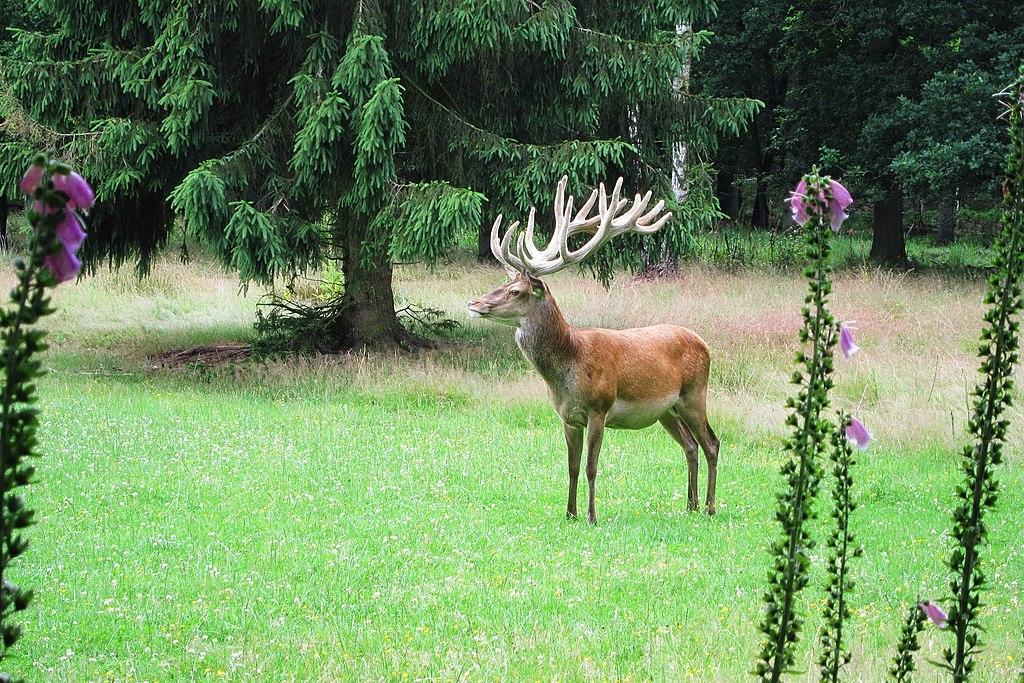
Even though deers will eat just about anything when starving, smart plant selection can save your garden from their wrath. Deer-resistant plants are way down on their menu since they are less palatable. However, once again, deer-resistant means that deer will be less likely to eat such plants, not that they will stay away from them entirely. Examples include Coneflower, Tickseed, Daffodil, and Larkspur.
Also, do not worry about the aesthetics. Growing deer-resistant plants can still provide a lush, beautiful, thriving garden. But what makes a plant repulsive to deer?
RELATED: 18 Low Growing Perennials Suitable For Your Gardenscapes
Plant Traits That Attract & Repel Deer
Before I provide you with a list of deer-resistant plants, I think it is crucial to understand the features of a garden and characters of plants that attract and repel deer. It would give you an idea of what makes a property more prone or safe to deer invasion.
Let’s start with what plants and garden features attract deer.
Why Won’t Deer Leave Your Garden Alone?
The plants in your backyard or garden should be a feast for the eyes, not a buffet for the local deer population. So, first up, don’t let your garden become a deer feast!
And how can you do that? Well, for starters, do not plant any nut or fruit trees. However, if you already have a few on your property, clean them or pick them thoroughly.
Also, avoid planting deer favorites such as hostas, pansies, yew, arborvitae, tulips, roses, and dogwood. Make fall cleanup your priority. You want to pick up as much edible debris as possible, or deer will come scouting for food and keep coming back.
Once deer have added your garden to their GPS, they won’t hesitate to make frequent pit stops. Also, deer have fantastic memory; even worse, they gossip with their friends.
What To Do To Save Your Garden From Deer?
To outwit the opportunistic deer, you need to create a garden that is less attractive to them. People often set up high fences or use various commercial and DIY deer repellents. Some even sprinkle a blood meal all over their garden to deter deer. And then there are those with bucks who set up motion-sensing sprinklers and lights to keep deer at bay.
However, I refuse to do that. Instead, I grow deer-resistant shrubs, herbs, and plants. You might ask what makes a plant resistant to deer. So, let’s answer that first!
Thorns
Would you eat something spiny or prickly? No, right? Well, neither do deer unless they are starving. They risk injuring their mouth and themselves when trying to eat. So, they keep their distance from plants with thorns, spines, or stinging-irritating hair.
Toxins/Bitterness
Many common garden plants are toxic, and deer will not go near them. Even if a plant is not poisonous or just bitter, deer will also avoid it. However, planting toxic plants can be problematic if you have children or pets who love putting everything in their mouths.
Texture
Deer eat plants that are juicy and soft. So, if you grow plants with a dry or rough texture, deer will detest them and stop regularly visiting your garden. The effect can be even stronger if you grow plants that smell terrible and have a rough texture simultaneously.
Smell
Deer do not like munching on plants that have a pungent smell. Therefore, do not plant sweet-smelling plants if you live in an area with deer. Instead, look for plants that have a sharp or strong fragrance. However, the smell alone might not be enough.
Therefore, you must find and grow plants that combine the features mentioned above or grow a combination of such plants with distinct traits that repel deer.
Nevertheless, enough chit-chat, no? So, now without further ado, on to our list!
Deer Resistant Perennial Plants & Herbs
1. Wall Germander (Teucrium chamaedrys)

Quick Facts & Features
| Plant Type | Herb |
| Geographical Origin | Mediterranean region |
| Ideal USDA Growing Zones | 5-9 |
| Mature Size | 30-60 cm (12-24 in); 30-45 cm (12-18 in) |
| Best Use Scenario | Rock gardens, borders, edging, herb gardens |
Overview & Deer Resistant Traits
Despite not receiving enough press and media attention these days, wall germanium was the star of herb and rock gardens a while ago. It is a shrubby, broadleaf evergreen grown chiefly for its aromatic foliage, and its foliage is what makes it repulsive to deer.
The reason for its aromatic foliage is that it contains terpenoids. These chemical compounds have a bitter taste and strong odor that repels deer. Furthermore, the leaves of Wall Germander are tough and leathery and not particularly palatable to deer.
Where To Buy?
2. Bog Onion (Arisaema triphyllum)

Quick Facts & Features
| Plant Type | Herbaceous perennial |
| Geographical Origin | North America |
| Ideal USDA Growing Zones | 4-9 |
| Mature Size | 30-60 cm / 12-24 inches; 15-30 cm / 6-12 inches |
| Best Use Scenario | Woodland gardens, shade gardens, naturalized areas, wildflower gardens |
Overview & Deer Resistant Traits
Bog Onion is a plant that can be easily pictured in a fairyland setting. It fascinates children and the young at heart alike. Its attraction lies in its unusual “flower,” which consists of an inner spadix (Jack) and a modified leaf structure -the spathe (the pulpit).
Nevertheless, the plant produces calcium oxalate crystals in its leaves and stem, which can cause a burning sensation in the mouth and throat if ingested. Therefore, even if desperate or hungry, deer do not like munching on Bog Onion when exploring.
Where To Buy?
5 JACK In THE PULPIT Arisaema Triphyllum Shade Flower Seeds
3. Bee Balm (Monarda didyma)

Quick Facts & Features
| Plant Type | Herbaceous perennial |
| Geographical Origin | North America |
| Ideal USDA Growing Zones | 4-9 |
| Mature Size | Height: 60-90 cm / 24-36 inches; Width: 30-45 cm / 12-18 inches |
| Best Use Scenario | Herb gardens, cottage gardens, pollinator gardens, cut flower gardens |
Overview & Deer Resistant Traits
Prized for its bright flowers and long bloom season, Bee Balm is one of the best plants for attracting and supporting wildlife while saving your garden from opportunistic deer.
Its name is a reference to its former use to treat bee stings.
Nevertheless, Bee Balm contains a pungent aromatic oil containing thymol, a natural insecticide and fungicide. And this is what gives Bee Balm its distinctive fragrance and makes it unpalatable to many animals, including deer and rabbits.
Where To Buy?
Scarlet Bee Balm (Monarda didyma) Packet of 12 seeds
4. Yarrow (Achillea millefolium)

Quick Facts & Features
| Plant Type | Herb |
| Geographical Origin | Europe, Asia, and North America |
| Ideal USDA Growing Zones | 3-9 |
| Mature Size (Height) | 30-60 cm / 12-24 inches |
| Mature Size (Width) | 30-60 cm / 12-24 inches |
| Best Use Scenario | Pollinator gardens, meadows, naturalistic plantings |
Overview & Deer Resistant Traits
Sold as a hardy and versatile perennial, Yarrow is a pest-resistant, drought-resistant plant that attracts butterflies and is excellent for use in borders, ground covers, and open meadows. In the southwestern U.S., you’ll hear it called a Plumajillo, Spanish for “little feather.”
Nevertheless, what makes Yarrow deer resistant is the strong scent and bitter taste that comes from lactones and alkaloids in its leaves, stems, and branches. These compounds, if ingested, can cause digestive problems, nausea, and other unpleasant effects.
Where To Buy?
5000 White Yarrow Seeds (Achillea millefolium)
5. Sneezeweed (Helenium autumnale)

Quick Facts & Features
| Plant Type | Herbaceous perennial |
| Geographical Origin | North America |
| Ideal USDA Growing Zones | 3-9 |
| Mature Size (Height) | 90-120 cm / 36-48 inches |
| Mature Size (Width) | 45-60 cm / 18-24 inches |
| Best Use Scenario | Garden borders, meadows, pollinator gardens |
Overview & Deer Resistant Traits
Unlike what its name suggests, sneezeweed is not a weed. And a yard full of sneezeweed plants will not make you sneeze. It gets its name from its historical use, where its dried leaves were often used in traditional settings to stop an unfortunate bout of sneezing.
Besides that, sneezeweed has a fuzzy or hairy texture that irritates a deer’s sensitive mouth and keeps them at bay. However, remember that the plant is not entirely deer-proof, and hungry deer may still nibble on sneezeweed if other food sources are scarce.
Where To Buy?
6. Rodgers Flower (Rodgersia pinnata)

Quick Facts & Features
| Plant Type | Herbaceous Perennial |
| Geographical Origin | Eastern Asia |
| Ideal USDA Growing Zones | 4-9 |
| Mature Size (Height) | 60-120 cm / 24-48 inches |
| Mature Size (Width) | 60-90 cm / 24-36 inches |
| Best Use Scenario | Borders, woodland gardens, shade gardens, or near-water features |
Overview & Deer Resistant Traits
Most people do not know about Rodgers flowers. What a pity! Its big leaves make a bold statement in the yard, and this adorable plant can be used in your landscaping in numerous ways. Furthermore, it can even grow in the wettest places where others plant fail.
Nevertheless, it is also its large leaves that make it less palatable to deer. The leaves are tough and have a leathery texture that can be difficult for deer to digest. Also, Rodgers Flower has a slightly bitter taste and a strong odor, which deer detest.
Where To Buy?
RODGERSIA Hardy Perennial Focal-Point Pinnata 10 Seeds
7. Coneflower (Echinacea spp.)

Quick Facts & Features
| Plant Type | Herbaceous Perennial |
| Geographical Origin | North America |
| Ideal USDA Growing Zones | 3-9 |
| Mature Size (Height) | 30-150 cm / 12-60 inches |
| Mature Size (Width) | 30-60 cm / 12-24 inches |
| Best Use Scenario | Borders, prairie or meadow gardens, cottage gardens, or as cut flowers |
Overview & Deer Resistant Traits
Coneflowers are outstanding prairie plants that are native to eastern America. There, it is hard to find a garden without at least one cultivar of these plants. And, Purple coneflower is arguably the most popular type of coneflower and one of my favorites too.
Coneflowers are generally considered deer-resistant, though the level of resistance is relative. For example, if the area’s deer population is exceptionally high and other food sources are scarce, deer might occasionally have a few bites of its leathery foliage.
Where To Buy?
250 Purple Coneflower Seeds (Echinacea Purpurea)
RELATED: Passion For Fashion: The Ultimate Guide To Passion Flowers
8. Forget-Me-Not (Myosotis sylvatica)

Quick Facts & Features
| Plant Type | Perennial herb |
| Geographical Origin | Europe |
| Ideal USDA Growing Zones | 3-8 |
| Mature Size | Height: 15-30 cm (6-12 inches); Width: 30-45 cm (12-18 inches) |
| Best Use Scenario | Ground cover, border plant, woodland garden, container |
Overview & Deer Resistant Traits
Forget-me-not is prized for its beautiful flowers. While the blooms are typically blue, other colors sometimes exist. And do you know what the best part is? The flowering buds that follow the blue flowers are pink, meaning you will get two colors for the price of one.
While forget-me-nots are generally not considered deer-resistant, their foliage and other plant parts contain alkaloids that make the plant unpalatable to deer. Furthermore, they have hairy leaves and stems, which may irritate deer’s sensitive mouthparts.
Where To Buy?
50 Mixed FORGET ME NOT Pink Blue White Seeds
9. Daffodil (Narcissus)

Quick Facts & Features
| Plant Type | Bulb |
| Geographical Origin | Mediterranean |
| Ideal USDA Growing Zones | 3-8 |
| Mature Size (Height x Width) | 30-40 cm x 10-15 cm / 12-16 in x 4-6 in |
| Best Use Scenario | Borders, beds, and rock gardens; naturalizing; cut flowers |
Overview & Deer Resistant Traits
Daffodils are amongst the most iconic decorative houseplants of the summer months. They are among the first flowers blooming in early spring, symbolizing hope and renewal. The primary colors are white and yellow, but you’ll also find shades of pink, red, and orange.
Daffodils have a hard and leathery texture that makes them unappealing to deer. Also, they are often planted in large clusters, which makes it difficult for deer to browse individual plants selectively. And even if that isn’t enough, they have toxic chemicals in their leaves.
Where To Buy?
Narcissus tazetta, French daffodil, seeds
10. Larkspur (Delphinium spp.)

Quick Facts & Features
| Plant Type | Perennial herb |
| Geographical Origin | Europe, North America |
| Ideal USDA Growing Zones | 3-9 |
| Mature Size (Height x Width) | 60-180 cm (24-72 in) x 30-60 cm (12-24 in) |
| Best Use Scenario | Cottage gardens, borders, cut flowers |
Overview & Deer Resistant Traits
Larkspur is a famed ornamental plant that brings a splash of color to indoor spaces and commercial parks. It is an easy-going plant, especially once established. Their blooms surround the stem, so they look like majestic pillars in the back of the backyard.
Larkspurs can grow quite tall, with some varieties reaching heights up to 6 feet. And this is what discourages the deer from munching on them. Even if deer manage to get to them, their leaves have a bitter taste and a pungent odor that can be unappealing to deer.
Where To Buy?
Larkspur Flowers Blend 0.2g – 50 Seeds
11. Rose Campion (Lychnis coronaria)

Quick Facts & Features
| Plant Type | Perennial herb |
| Geographical Origin | Southern Europe |
| Ideal USDA Growing Zones | 4-8 |
| Mature Size (Height x Width) | 60-90 cm (24-36 in) x 30-45 cm (12-18 in) |
| Best Use Scenario | Cottage gardens, borders, rock gardens, cut flowers |
Overview & Deer Resistant Traits
Rose campion is an old-fashioned favorite that adds a splash of color to the flower garden in shades of pink, red, and white. It is again gaining popularity in drought-tolerant, naturalistic, and wildlife-friendly planting. And, even better, it is low-fuss and easy to grow.
In general, deer tend to avoid Rose Campion plants as they have a bitter or soapy taste, a pungent aroma, and rough textures that they find unpalatable. The soapy taste comes from chemical saponins, which can cause digestive upset and even poison deer.
Where To Buy?
500 Organic Lychnis Coronaria Rose Campion Flower Seeds
12. Columbine Meadow Rue (Thalictrum aquilegifolium)
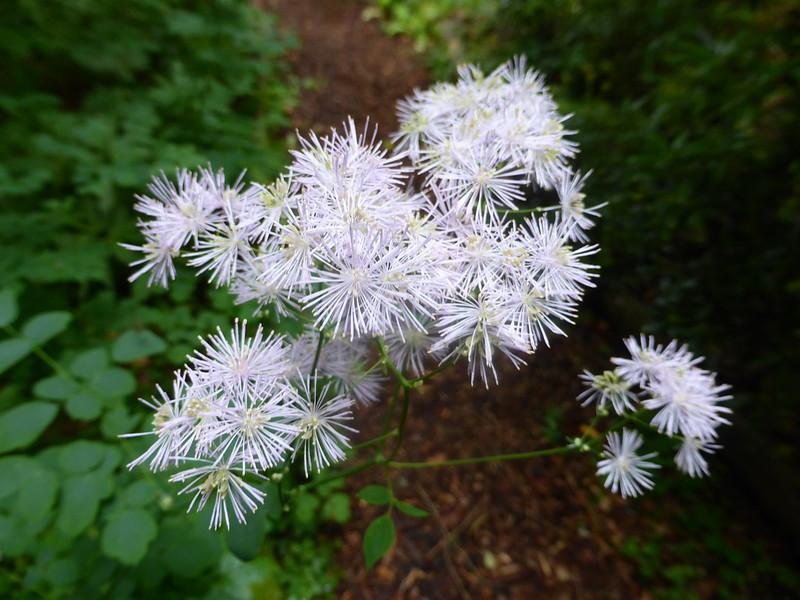
Quick Facts & Features
| Plant Type | Perennial herb |
| Geographical Origin | Europe, Asia |
| Ideal USDA Growing Zones | 4-8 |
| Mature Size (Height x Width) | 90-150 cm (36-60 in) x 30-60 cm (12-24 in) |
| Best Use Scenario | Cottage gardens, borders, woodland gardens, cut flowers |
Overview & Deer Resistant Traits
The lacy leaves of Columbine Meadow Rue resemble a columbine’s, giving this plant its common and scientific names. The plant produces hundreds of frilly lavender-pink flowers atop dark-colored stems in mid-spring and into summer.
However, don’t let this plant’s delicate looks fool you. It is pretty hardy and immune to deer.
It contains alkaloids and other compounds that can cause digestive upset and give the plant an overall bitter taste, keeping the browsing deer away.
Where To Buy?
Thalictrum Aquilegifolium-15 seeds/HP
13. Jack Frost Bugloss (Brunnera macrophylla ‘Jack Frost’)
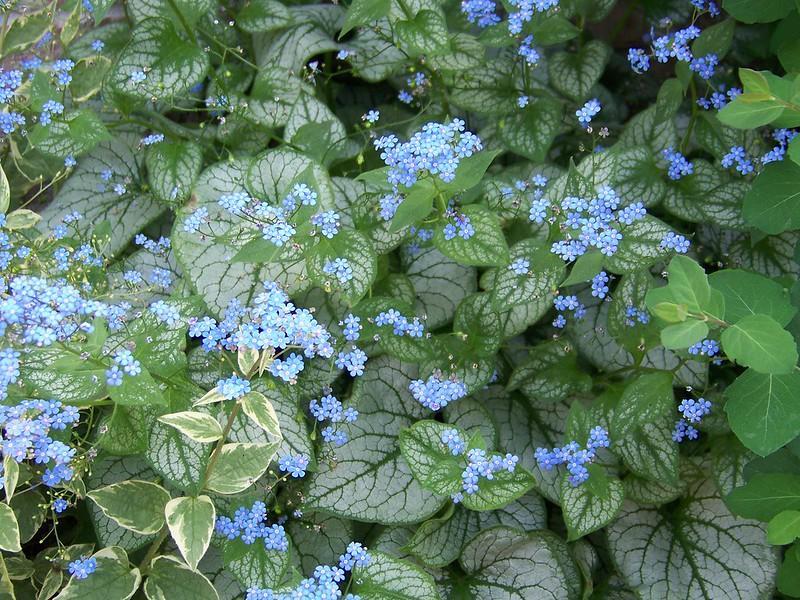
Quick Facts & Features
| Plant Type | Perennial herb |
| Geographical Origin | Caucasus |
| Ideal USDA Growing Zones | 3-8 |
| Mature Size (Height x Width) | 30-45 cm (12-18 in) x 45-60 cm (18-24 in) |
| Best Use Scenario | Woodland gardens, shady borders, ground cover, container plantings |
Overview & Deer Resistant Traits
The plant is known for its heart-shaped leaves, and its petite blooms compliment its attractive, glossy foliage. It is an herbaceous perennial, dying back in winter. Furthermore, the leaves are intricately detailed with deep green veining, giving them a unique look.
If you look at the plant’s stems and branches, you will see tiny hairs which irritate the deer’s mouth, thus making the plant less prone to deer attacks. However, the plant is not entirely immune to deer attacks, and given a chance, a deer might munch on it.
Where To Buy?
14. Oriental Poppy (Papaver orientale)
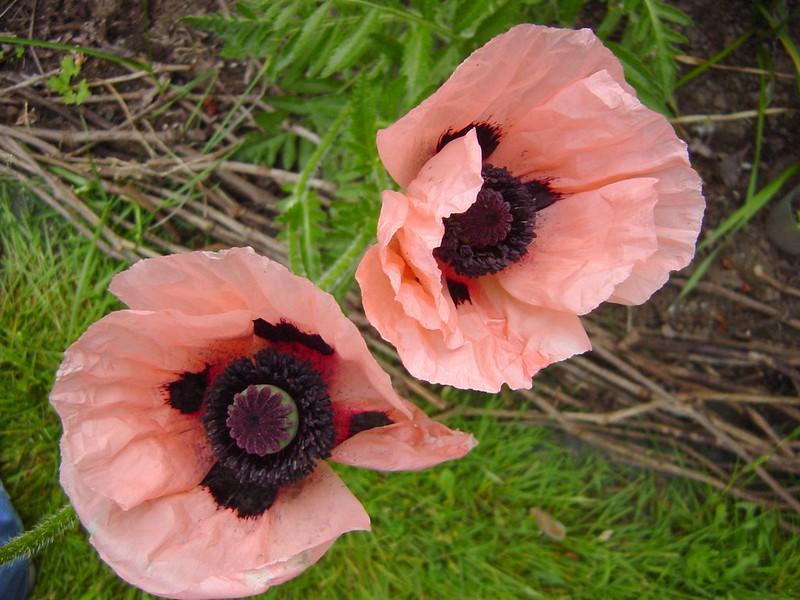
Quick Facts & Features
| Plant Type | Perennial herb |
| Geographical Origin | Western Asia, Eastern Europe |
| Ideal USDA Growing Zones | 3-7 |
| Mature Size (Height x Width) | 60-90 cm (24-36 in) x 30-45 cm (12-18 in) |
| Best Use Scenario | Cottage gardens, borders, rock gardens, cut flowers |
Overview & Deer Resistant Traits
These plants are grown typically grown for their flowers. However, in spring, the plants also bear attractive foliage. However, if you decide to plant them, remember they need years of care before they reach maturity and fill your garden with lovely blossoms and leaves.
Unlike many plants mentioned in the list, Oriental Poppy has no toxic chemicals that make it less palatable to deer. However, all parts of the plant contain a milky fluid. The milky sap can irritate the skin and mucus layers if touched or ingested, which keeps the deer away.
Where To Buy?
100 “Deluxe Mix” Oriental Poppy Flower Seeds
15. Peony (Paeonia lactiflora)
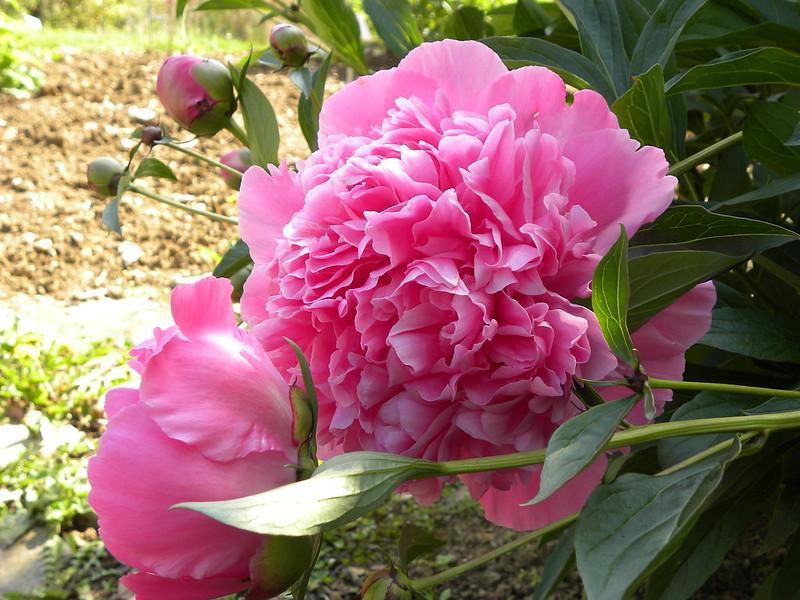
Quick Facts & Features
| Plant Type | Perennial |
| Geographical Origin | China, Japan, and Korea |
| Ideal USDA Growing Zones | 3 to 8 |
| Mature Size (Height) | 60-100 cm or 24-39 inches |
| Mature Size (Width) | 60-90 cm or 24-35 inches |
| Best Use Scenario | Flower borders, cut flowers, and mass planting |
Overview & Deer Resistant Traits
The Peony is outrageously gorgeous in bloom with the most delicious flowers, the fattest flowers, and lush green leaves. Furthermore, it is a perennial, so its flowers return year after year to take your breath away and fill your garden with its pretty blooms.
However, don’t let its delicate looks fool you. Peonies have tough, leathery leaves that are difficult for deer to digest. Also, since the deer rely on their sense of smell to find food, the pungent aroma of Peony leaves deters them from munching on the plant.
Where To Buy?
Paeonia suffruticosa mix colors 5 PCS fresh seeds
16. Lenten Rose (Helleborus orientalis)

Quick Facts & Features
| Plant Type | Perennial |
| Geographical Origin | Greece and Turkey |
| Ideal USDA Growing Zones | 4-9 |
| Mature Size (Height x Width) | 12-18 inches (30.48-45.72 cm) x 12-18 inches (30.48-45.72 cm) |
| Best Use Scenario | Woodland gardens. |
Overview & Deer Resistant Traits
Although it has the word “rose” in its name, it is not a rose but a perennial hybrid hellebore that belongs to the buttercup family of plants. These plants bloom in early spring and often during the Lent season, hence the name Lenten Rose. The most widely known Lenten rose has vibrant red or light yellow-green petals and rich dark-green foliage.
Lenten Rose contains toxic compounds such as helleborin and hellebrin. These chemicals can cause digestive problems if ingested. Therefore, deer and other herbivores, such as rabbits, often avoid feeding on the foliage and blooms of Lenten Rose.
Where To Buy?
Fresh (2022) Helleborus Lenten Rose Seeds – Mixed Color
17. Lamb’s Ear (Stachys byzantina)

Quick Facts & Features
| Plant Type | Perennial |
| Geographical Origin | Armenia, Iran, and Turkey |
| Ideal USDA Growing Zones | Not specified |
| Mature Size (Height x Width) | 18 inches (45.72 cm) x 18 inches (45.72 cm) |
| Best Use Scenario | Dry to medium-moisture soil in a sunny location |
Overview & Deer Resistant Traits
Lamb’s ear is a sun-loving perennial that spreads quickly, making it an ideal ground cover for sunny areas. People often plant it for its texture, and it is usually recommended for children’s gardens because of its soft woolly foliage, which is also the reason behind its name.
And, since the foliage of this plant is fuzzy and hairy, almost velvety in texture, deer typically find it unappealing. Furthermore, the nutritional content of its leaves is too low, and it does not make great food for herbivores, so they are less likely to target it as food.
Where To Buy?
Lamb’s Ear Stachy Byzantina Flower Seeds/Perennial 50+
18. Bearded Iris (Iris germanica)
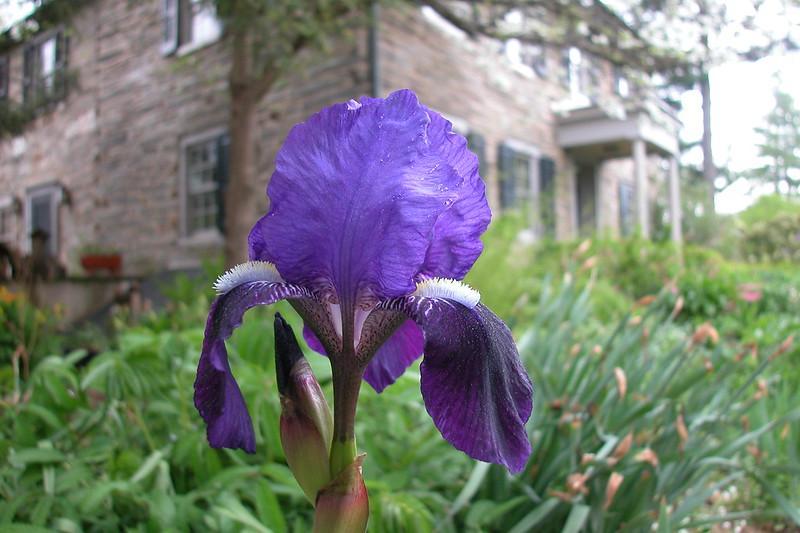
Quick Facts & Features
| Plant Type | Perennial |
| Geographical Origin | Unknown parentage |
| Ideal USDA Growing Zones | 3 to 9 |
| Mature Size (Height x Width) | Up to 120 cm (47 in) high and 30 cm (12 in) wide |
| Best Use Scenario | Hot sunny borders |
Overview & Deer Resistant Traits
It’s a magical time when bearded iris unfurls their tiny buds to reveal a splash of color in March in warmer regions. Each flower comprises inner petals and large outer, known as falls and ruffs. It is one of the most popular garden plants and is among the easiest to grow.
Its leaves contain toxic compounds that cause vomiting and diarrhea in deer if ingested in large quantities. The toxic compounds in its leaves also make it bitter; thus, deer are less attracted to it. Furthermore, the texture of its leaves makes it difficult to chew and digest.
Where To Buy?
Iris Germanica Blue Yellow Bearded Iris Fresh Rhizome
19. Salvia (Salvia spp.)

Quick Facts & Features
| Plant Type | Herbaceous Perennial |
| Geographical Origin | Americas, Asia, Europe |
| Ideal USDA Growing Zones | 3-10 |
| Mature Size (Height) | 15-120 cm / 6-48 inches |
| Mature Size (Width) | 30-120 cm / 12-48 inches |
| Best Use Scenario | Border, Container, Drought-Tolerant Garden, Herb Garden, Rock Garden |
Overview & Deer Resistant Traits
Part of the mint family, salvias produce colorful spikes of densely-packed flowers with tubular blossoms that can add a splash of color to any backyard or garden. They are native to dry and hot climates and provide gardeners with many shades of color and smells.
The properties that make them less palatable to deer include a pungent smell, rough-textured foliage, and the bitter taste of leaves due to toxic compounds.
Where To Buy?
Salvia seeds- Diviner’s Sage, Lady Salvia, Magic Mint, Purple Sticky
20. Foxglove (Digitalis purpurea)

Quick Facts & Features
| Plant Type | Biennial or Perennial |
| Geographical Origin | Europe, North Africa |
| Ideal USDA Growing Zones | 4-8 |
| Mature Size (Height) | 90-180 cm / 36-72 inches |
| Mature Size (Width) | 30-60 cm / 12-24 inches |
| Best Use Scenario | Cottage Garden, Shade Garden, Woodland Garden |
Overview & Deer Resistant Traits
Tall and stately foxglove plants have long been used in gardens and parks where flowers and vertical interest are desired. They make stunning cut flowers, need little care, are deer-resistant, attract bees and butterflies and bloom heavily in early spring.
Part of their deer resistance comes from digitoxin and digitalin compounds, which can cause nausea, vomiting, and other symptoms if ingested by deer or other herbivores.
Where To Buy?
Digitalis purpurea “Pink Foxglove” 200 Seeds
21. Yellow Alyssum (Aurinia saxatilis)

Quick Facts & Features
| Plant Type | Perennial |
| Geographical Origin | Europe, Western Asia |
| Ideal USDA Growing Zones | 4-7 |
| Mature Size (Height) | 15-30 cm / 6-12 inches |
| Mature Size (Width) | 30-60 cm / 12-24 inches |
| Best Use Scenario | Border, Rock Garden, Ground Cover |
Overview & Deer Resistant Traits
Yellow alyssum, or basket-of-gold, is a perennial plant with a spreading habit. Its blooms appear in clusters and are plentiful. And while they look stunning as a groundcover, you should not expect a good scent; the flowers are, in fact, quite bad-smelling.
And these bad-smelling flowers are part of why deer will not come around them for food. Furthermore, its leaves have a fuzzy texture, making swallowing difficult for deer.
Where To Buy?
25 Seeds Golden Ball Alyssum Flower Seeds, Heirloom
22. Dutchman’s Breeches (Dicentra cucullaria)

Quick Facts & Features
| Plant Type | Perennial |
| Geographical Origin | Eastern North America |
| Ideal USDA Growing Zones | 3-7 |
| Mature Size (Height) | 15-30 cm / 6-12 inches |
| Mature Size (Width) | 15-30 cm / 6-12 inches |
| Best Use Scenario | Shade Garden, Woodland Garden |
Overview & Deer Resistant Traits
These plants are called Dutchman’s Breeches because their blooms resemble the pantaloons that Dutch people wore around the 16th century. Sometimes it is also referred to as Little Blue Staggers because of its ability to induce drunken staggering in cattle.
The power comes from narcotic substances in their leaves. Furthermore, its leaves also contain alkaloids, including dicentrine and fumaric acid. These compounds induce vomiting and nausea if ingested by the deer, so they often stay away from these plants.
Where To Buy?
5 Wild Dutchman’s Breeches Dicentra cucullaria Bulbs
23. Fringed Bleeding Hearts (Dicentra eximia)

Quick Facts & Features
| Plant Type | Perennial |
| Geographical Origin | Eastern North America |
| Ideal USDA Growing Zones | 3-9 |
| Mature Size (Height) | 30-45 cm / 12-18 inches |
| Mature Size (Width) | 30-45 cm / 12-18 inches |
| Best Use Scenario | Border, Container, Shade Garden, Woodland Garden |
Overview & Deer Resistant Traits
While not the showiest, these plants are valued by homeowners who appreciate the delicacy of flowers. They are shade-loving and bloom in the cool of spring, and after flowering for a few weeks, the plants disappear, but the roots stay alive, and the plant will return every year.
Fringed bleeding heart plants have finely divided, fern-like leaves with a delicate texture that makes them less appealing to deer, and they would rather stay away from them.
Where To Buy?
Fringed Bleeding Heart * Compact Perennial Bush * 5 Seeds
24. Common Bleeding Hearts (Lamprocapnos spectabilis)

Quick Facts & Features
| Plant Type | Perennial |
| Geographical Origin | Siberia, Northern China, Korea |
| Ideal USDA Growing Zones | 3-9 |
| Mature Size (Height) | 60-120 cm / 24-48 inches |
| Mature Size (Width) | 60-90 cm / 24-36 inches |
| Best Use Scenario | Shade Garden, Woodland Garden |
Overview & Deer Resistant Traits
These plants have characteristic heart-shaped flowers that bloom in pink, red, or white shades. The plant grows in loose clumps and has delicate arching branches on which these blooms appear. You can grow these plants outside in a garden or indoors as houseplants.
Their deer-resistant traits come from chemicals such as isoquinoline alkaloids in their leaves. These chemicals are bitter and can cause digestive upset in deer, so they stay away.
Where To Buy?
Bleeding Hearts plant roots/rhizomes (Dicentra spectabilis)
25. Speedwell (Veronica spp.)

Quick Facts & Features
| Plant Type | Perennial |
| Geographical Origin | Europe, North America |
| Ideal USDA Growing Zones | 3-9 |
| Mature Size (Height) | 15-90 cm / 6-36 inches |
| Mature Size (Width) | 30-60 cm / 12-24 inches |
| Best Use Scenario | Border, Ground Cover, Rock Garden |
Overview & Deer Resistant Traits
For gardeners with limited time, speedwell is an ideal choice. It is a low-fuss plant with carefree and low-maintenance nature. The plant produces showy spikes of long-lasting flowers that begin blooming in spring or early summer. Furthermore, it attracts plenty of wildlife, including bees, butterflies, hummingbirds, and other songbirds.
However, despite attracting nectar-feeding wildlife, the plant is not well-liked by deer because its bitter leaves are not good food sources for herbivores.
Where To Buy?
50+ Veronica Oxford Blue / Creeping / Speedwall / Perennial / Flower Seeds.
26. Lungwort (Pulmonaria officinalis)
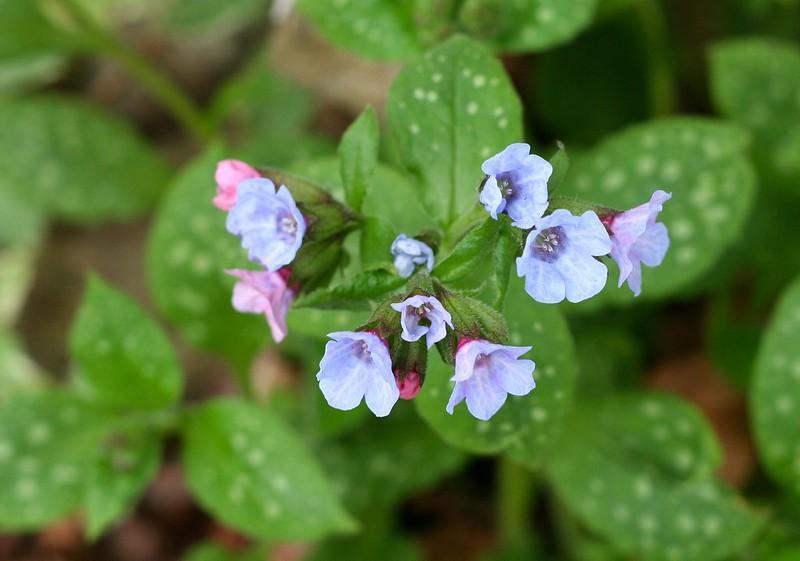
Quick Facts & Features
| Plant Type | Perennial |
| Geographical Origin | Europe, Western Asia |
| Ideal USDA Growing Zones | 4-8 |
| Mature Size (Height) | 30-45 cm / 12-18 inches |
| Mature Size (Width) | 30-45 cm / 12-18 inches |
| Best Use Scenario | Border, Shade Garden, Woodland Garden |
Overview & Deer Resistant Traits
The lungwort plant is known for its medicinal properties, believed to cure lung diseases. However, people also call it Bethlehem sage and Jerusalem cowslip. It produces bell-shaped flowers that start pinkish, then mature to a violet-blue before falling.
The leaves of the lungwort plant contain alkaloids which are bitter-tasting chemicals. Also, they are rough in texture, so deers usually avoid munching on them unless starving.
WhereTo Buy?
27. Russian Sage (Perovskia atriplicifolia)

Quick Facts & Features
| Plant Type | Perennial |
| Geographical Origin | Central Asia |
| Ideal USDA Growing Zones | 5-9 |
| Mature Size (Height) | 60-90 cm / 24-36 inches |
| Mature Size (Width) | 60-90 cm / 24-36 inches |
| Best Use Scenario | Border, Drought-Tolerant Garden, Rock Garden |
Overview & Deer Resistant Traits
If you’re a lazy gardener, you want plants you can stick in the ground and ignore.
Then you hope that they look stunning. These plants are difficult to find, but since you are here, let’s introduce you to Russan Sage. It is a beautiful plant with abundant, spiky clusters of flowers that bloom from late spring until autumn. However, despite being a treat for the eyes, it is not for deer. It has a woody texture and a slightly bitter taste, which deer detest.
Where To Buy?
Russian Sage Seeds (Perovskia atriplicifolia) Packet of 10 Seeds
28. English Lavender (Lavandula angustifolia)

Quick Facts & Features
| Plant Type | Herb |
| Geographical Origin | Mediterranean |
| Ideal USDA Growing Zones | 5-9 |
| Mature Size (Height) | 30-60 cm / 12-24 inches |
| Mature Size (Width) | 30-90 cm / 12-36 inches |
| Best Use Scenario | Borders, herb gardens, pots, dried flower arrangements |
Overview & Deer Resistant Traits
Also known as true lavender. It is often planted commercially because of its culinary and medicinal use, and it also makes an excellent source for making perfumes. It is named so as it grows well in that country’s cooler climate and is a staple in English herb gardens.
Its deer-resistant characteristics come from its foliage, which contains essential oils that give it a strong scent and a slightly bitter taste, unappealing to deer and herbivores.
Where To Buy?
250 Lavender seeds | Lavandula angustifolia | Farmer Seeds
29. Catmint and Catnip (Nepeta spp.)

Quick Facts & Features
| Information | Catmint | Catnip |
| Plant Type | Herb | Herb |
| Geographical Origin | Europe, Asia | Mediterranean, Asia |
| Ideal USDA Growing Zones | 3-8 | 3-9 |
| Mature Size (Height) | 30-60 cm / 12-24 inches | 30-100 cm / 12-39 inches |
| Mature Size (Width) | 30-90 cm / 12-36 inches | 30-90 cm / 12-36 inches |
| Best Use Scenario | Borders, herb gardens, ground cover | Herb gardens, containers, tea, cat toys |
Overview & Deer Resistant Traits
A reliable, long-lived perennial, catmint produces scented gray-green foliage and vertical flower spikes in lavender, pink or white shades. It is a tough-as-nails plant and will bloom for months with little care and ensure you purr with delight. And while Catmint and Catnip are considered deer-resistant, they might take a hit if the population is high.
Where To Buy?
Catnip Seeds | Nepeta cataria | 100+ seeds
30. False Indigo (Baptisia australis)

Quick Facts & Features
| Plant Type | Herbaceous Perennial |
| Geographical Origin | Eastern and Central North America |
| Ideal USDA Growing Zones | 3-9 |
| Mature Size (Height) | 90-120 cm / 36-48 inches |
| Mature Size (Width) | 90-120 cm / 36-48 inches |
| Best Use Scenario | Borders, wildflower meadows, cut flowers |
Overview & Deer Resistant Traits
If you’re looking for a striking deer-resistant plant that needs little care to produce good results, take a good look at Baptisia. It has grey-green and beautiful long racemes of indigo-blue flowers that appear near the spring and into the summer.
The flowers grow on woody stems and rough-textured leaves, which is part of why deer do not munch on them. Aside from that, the plant contains alkaloids which deer also detest.
Where To Buy?
50 BLUE WILD INDIGO (False Indigo) Baptisia Australis Flower Seeds
31. Ornamental Onion (Allium schubertii)

Quick Facts & Features
| Plant Type | Bulb |
| Geographical Origin | Middle East |
| Ideal USDA Growing Zones | 5-9 |
| Mature Size (Height) | 45-60 cm / 18-24 inches |
| Mature Size (Width) | 15-30 cm / 6-12 inches |
| Best Use Scenario | Borders, rock gardens, cut flowers |
Overview & Deer Resistant Traits
A lot of us don’t think of onions as beautiful plants. However, onions have a few cousins that deserve a place in your garden. And one of them is ornamental onions. These fast-growing alliums grow tall and have round flower heads with dozens of stunning flowers.
And, just like onions, they have a pungent smell. Furthermore, they have a tough, fibrous texture and a relatively low nutritional value which keeps the deer at bay.
Where To Buy?
Purple Giant Onion Flower ( Allium giganteum ) 50 Seeds
32. Heartleaf Brunnera (Brunnera macrophylla)

Quick Facts & Features
| Plant Type | Herbaceous Perennial |
| Geographical Origin | Caucasus, Eastern Europe |
| Ideal USDA Growing Zones | 3-8 |
| Mature Size (Height) | 30-45 cm / 12-18 inches |
| Mature Size (Width) | 45-60 cm / 18-24 inches |
| Best Use Scenario | Woodland gardens, shaded borders, ground cover |
Overview & Deer Resistant Traits
Commonly known as false forget-me-not, the plant has petite blooms complimenting its attractive, glossy foliage. It is one of my favorite plants to add to a shade garden. The plants form tidy clumps and can reach up to 18 inches in size, with leathery, hairy leaves.
And these tough, chewy, and hairy leaves are part of why deer will not come near it. Also, its leaves have alkaloids that give it a bitter taste, which deer don’t like.
Were To Buy?
Brunnera ‘Jack Frost’ Heartleaf Alkanet, Siberian Bugloss
The Bottom Line
And there you have it! A comprehensive list of deer-resistant perennials, shrubs, and herbs. There is no reason why your garden cannot look stunning and jaw-dropping just because you live in an area with a deer population. All you have to do is pick the right plants, and you are good to go. However, please remember that no plant is entirely deer-resistant.
If the deer population is high or deer are starving, it might take a few bites from these plants too. However, the damage will be much less than ordinary garden plants.
Frequently Asked Questions (FAQs)
What is the most deer-resistant plant?
It is hard to say for sure which plant is most deer-resistant. In general, however, deer will avoid anything spiny or fuzzy. Also, they avoid statuesque plants such as yews and boxwoods and generally dislike plants with aromatic foliage, such as rosemary and sage.
Are geraniums deer resistant?
You can use geraniums as a deer-resistant plant, but please remember they are not entirely safe from deer. However, they will likely recover from deer damage relatively quickly.
What smell do deer hate the most?
Some smells that deer react negatively to include mint, eggs, garlic, and clove. You can also spray vinegar on your plants to keep deer away. However, you must use vinegar carefully.
Are marigolds deer resistant?
Even though not entirely safe from deer attacks, all varieties of marigolds are a turnoff for deer because of their spicy scent. So, if you do not want deer, plant them.
What scares deer away?
If you do not want deer in your garden, a radio activated by a motion detector will do the trick. However, if you do not want to do that, water sprayers or sprinklers activated by motion sensors and lashing and strobe lights can also help you to keep them at bay.
Sources for Further Reading
Deer Resistant Native Plants | The University of Maryland Extension. (2023). Retrieved 22 March 2023, from https://extension.umd.edu/resource/deer-resistant-native-plants
Top Deer Resistant Plants | The Mississippi State University Extension Service. (2023). Retrieved 22 March 2023, from https://extension.msstate.edu/blog/top-deer-resistant-plants
Deer Resistant-Tolerant Plants – Science-Based Solutions for Ventura County’s Communities, Farms and Environment. (2023). Retrieved 22 March 2023, from https://ceventura.ucanr.edu/Gardening/Coastal/Landscape_578/Deer/
Do you know of other deer resistant perennials? Do share it with us in the comment section below. Also, check out our other articles:
Top 20 Yellow Perennials To Brighten Up Your Home | The Ultimate Guide
Hydrangea: How To Save Your Gorgeous Plant From Turning Brown
How To Protect Hostas From Snails & Slugs? The Ultimate Guide







